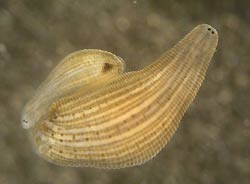Berkeleyan
Lucky species queue up to have their genomes sequenced
It’s ‘fun detective work,’ but with significant potential impacts
![]()
| 02 September 2004
 One adult and one juvenile of the leech Helobdella robusta. The pair of black dots are eyespots or photosensors. These animals were being prepared for transport from Berkeley to the Joint Genome Institute as part of a Community Sequencing Program. (Ajna S. Rivera photo) |
The moss, leech, and parasite were among some two dozen organisms selected last week by the Department of Energy’s Joint Genome Institute (JGI) as the focus of their sequencing efforts over the next year.
The 23 projects — which include the moss genome project proposed by moss connoisseur and systematist Brent Mishler of UC Berkeley; the leech genome project proposed by Berkeley developmental biologist David Weisblat; and the parasite project proposed by Berkeley cell biologist W. Zacheus Cande — were chosen in part to provide researchers with genomes from a wide range of Earth’s organisms, both plant and animal. But these organisms also are important economically or as disease pathogens, or are widely used research creatures in laboratories around the world.
Mishler called the moss genome project “a triumph for international plant science,” complementing the handful of plant genomes known so far, including rice, corn, the mustard Arabidopsis and, soon to be complete, the poplar tree.
Other organisms chosen for sequencing include an alga and the bacterium that causes Staph infections, plus a marine phytoplankton and two types of marine worms.
“The selections represent a rich diversity of microbes as well as higher plants and animals that inhabit both aquatic and terrestrial ecosystems,” said Eddy Rubin, JGI director. “By making JGI’s powerful resources available to non-traditional end-users of sequence through the Community Sequencing Program, we hope to advance knowledge across such vital topics as alternative energy production and biore-
mediation, and to address important questions of evolution and development.”
Over the next year, JGI will devote nearly half its sequencing capacity to the projects, chosen from 60 proposals submitted earlier this year. JGI operates 100 DNA sequencers at its Walnut Creek Production Genomics Facility, capable of sequencing more than 30 billion letters of genetic code (30 gigabases) each year.
Once the sequencing is complete, Mishler, Weisblat, Cande and their colleagues will end up, not with a complete list of the genes in each organism, but rather the raw sequences of DNA bases on each chromosome. The pinpointing and identification of genes within this sequence — a process called annotation —requires much more work on the part of researchers around the world. For example, the commond mustard weed Arabidopsis, whose genome was sequenced in 2000, won’t be completely annotated until 2010, Mishler noted.
“It’s fun detective work,” said Mishler of the annotation jamborees that draw many researchers together to look for genes among the raw sequence data. “But we’re going to have to do a lot of work to annotate, including using classical genetics with crosses to map genes the old fashioned way, by looking to see if they’re linked on the same chromosome or not.”
A complete list of organisms to be sequenced as part of JGI’s Community Sequencing Program can be found online at www.jgi.doe.gov/sequencing/cspseqplans.html.

